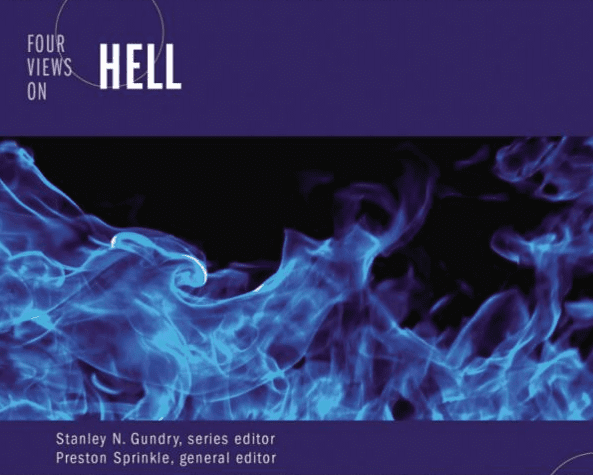This post is by Terry Tiessen, and I use the post with his permission.
I set out to write a blog post that grew rather large. So I have decided to split it into two posts, of which this is the first. Here I will relate the story of my long journey in quest of a biblical answer to that big question. In Part 2, I will recommend a book which I believe contributes very helpfully to the conversation about this issue which I believe needs to happen among evangelicals. It ought to be a conversation in which all of the participants are reasonable, charitable, and thoroughly committed to letting God speak to us as we discuss issues of great import.
My own journey thus far
As I review the process of my understanding of the Bible’s teaching regarding hell, I find that I have now gone through 5 stages of a theological journey.
Stage 1: Convinced that the traditional view of hell as eternal conscious torment is the orthodox view and is clearly taught in Scripture.
I grew up in the home of missionaries and spent most of my childhood years at the British boarding school which was the most common choice for families from Commonwealth nations. In all of my years through high school, I recall being taught consistently that God would punish unrepentant sinners with a conscious and endless suffering so severe that it was analogous to the pain of being burned, but worse because it never stopped.
In Bible College and my first graduate school experience, I learned that there were people who believed that God would eventually annihilate the wicked. But those who believed this were portrayed as either members of “false cults,” like Jehovah’s Witnesses, or Protestant Liberals who had abandoned orthodox Christian beliefs on even more fundamental points. The Seventh Day Adventists also believed this but they were more difficult to place, and their annihilationism was less problematic than the authority of Ellen White and the doctrine of the “investigative judgment.” (This hierarchy of issues is evident in the 2007 “Joint Statement of the World Evangelical Alliance and the Seventh-day Adventist Church.” Annihilationism does not come up as an issue between evangelicals and the SDA in that conversation.)
Stage 2: Aware that some thoroughly orthodox evangelicals were annihilationists, and convinced that this is a viable alternative within evangelicalism, while remaining a traditionalist myself.
I have been a member of the Evangelical Theological Society since 1967, and I’ve read itsJournal with significant benefit. I consider it a fair representation of what is going on within evangelicalism, particularly what might now be deemed “conservative evangelicalism” as distinct from fundamentalism on one side and “post-conservative evangelicalism” on the other. In recent years, I discern a more fundamentalistic spirit with the Society, and I observe that this has alienated many who might be dubbed “post-conservative.” But back in the pleasant days of 1985, no one talked about “post-conservative evangelicalism,” and JETSlooked to me like a good mirror of evangelicalism in general, along with Christianity Todayat the magazine level, though the latter became rather more popular in style than when I first subscribed, when Carl Henry was the editor.
So, when I read Edward Fudge’s article in the September 1984 issue of JETS (“The Final End of the Wicked”), the thought that an evangelical might be an annihilationist was rather new to me. I remember reading that article with keen interest and, not long afterwards, I read the first edition of Fudge’s 1982 book, The Fire that Consumes, now in its third edition. I found Fudge’s book to be a very thorough examination of everything the Bible has to say about the nature of God’s final punishment of sinners, and I was happy to meet him at an ETS meeting a few years later. By then, it was clear to me that a strong biblical case could be made for annihilation and that the traditional view of eternal conscious torment, though very widespread since Augustine, was not the only option within the evangelical tent.
Stage 3: Aware of the strong antipathy of many evangelical theologians to evangelical annihilationists, and of passionate commitment to the traditional view within significant sectors of evangelicalism. I realized that the stakes could be high for dissenters.
In 1989, the National Association of Evangelicals and Trinity Evangelical Divinity School convened a consultation on Evangelical Essentials, with 650 registered participants, “to unite evangelicals in their commitment to the great biblical truths of our faith” (Evangelical Affirmations, 13). The organizers did not intend to produce a short evangelical creed, nor did they assume that all agree together if that were attempted. But, in the “Preface” to the book they later edited, Kenneth Kantzer and Carl Henry said that they sought to formulate a “confession of what it means to be an evangelical. In a day when this term is used loosely to cover a broad variety of belief and unbelief we trust that a clear statement of those common convictions that constitute our evangelical heritage will prove useful to the church” (pp. 14-15, emphasis supplied).
At that conference, J. I. Packer did a presentation on “Evangelicals and the Way of Salvation: New Challenges to the Gospel: Universalism, and Justification by Faith.”
Along the way, he decided to mention the “challenge” of annihilationism:
Now we turn to the second proposed revision of historic evangelical soteriology, the view that the question of salvation is less agonizing than we thought because after judgment day the unsaved will not exist. This is universalism in reverse: like universalism, it envisages a final state in which all are saved; unlike universalism, it anticipates, not post-mortem conversion, but annihilation and non-being for those who leave this world in unbelief. The exponents of this view, which for our purposes may be called either annihilationism or conditionalism, are all Protestants or cultists. Having been condemned at the fifth lateran Council in 1513, it is not an option for Roman Catholics. Among the Protestants are some distinguished evangelicals, including recently my fellow Anglicans John Stott and Philip Edgcumbe Hughes, and I think it is currently gaining more evangelical adherents. But the question, whether an opinion is true, is not resolved by asking who holds it.
Packer went on to assert that “conditionalism is never advocated as expressing the obvious meaning of Scripture, for this it does not do. Its advocates back into it, rather, in horrified recoil from the thought of billions in endless torment — a thought to which the memory of Hitler’s holocaust, and the modern statistical mind-set, no doubt add vividness.”
At that time, I accepted Packer’s assessment that the primary motive accounting for evangelicals being attracted to annihilationism was emotive. I often heard that charge later, but I now know that it is wrong to paint all evangelical annihilationists with that brush. By then, Edward Fudge’s calm, reasonable, and exhaustive study of Scripture was in print, without any of the hysterics that Packer said lay behind this trend. Nor could either of Packer’s fellow Anglicans, Stott and Hughes, be rightly charged with this. What Packer’s remarks impressed upon me, however, was the strength of his conviction that annihilationism is aberrant, unbiblical and dangerous; evangelicals should be concerned about its arising in their midst. This attitude was reenforced by an even stronger expression of concern from John Ankerberg, in his official response to Packer’s presentation:
The doctrine of eternal punishment is interrelated with many other doctrines. It conditions our thinking in many areas of preaching and teaching. When friends, such as John Stott, Philip Edgcombe Hughes, Clark Pinnock, John Wenham, Basil Atkinson and other well-known and reputedly evangelical leaders, reject the traditional view of eternal punishment, the Church suffers serious or even fatal erosion in its doctrinal foundation (pp. 140-41, emphasis supplied).
Remarks like this from evangelical leaders should not be taken lightly. Any evangelicals who might be otherwise impressed with the strength of the biblical case for annihilationism, as I was, obviously needed to be very cautious about joining the little company who had stuck their heads out. John Stott was clearly aware of this himself, and it was for this reason that he had not revealed for many years that he did not believe the traditional view of eternal conscious torment. But when David L. Edwards put him on the spot, during theirLiberal/Evangelical dialogue, Stott felt compelled to explain that he did not personally affirm that traditional view.
As I heard the story from one of the participants in the 1989 conference, the original draft of “evangelical affirmations” had included a statement regarding hell which was phrased in terms of eternal conscious torment. The book in which John Stott went public about his eschatology had only recently been published and so Packer’s mention of Stott as an annihilationist was news to many of the participants. But, given the very high regard which evangelicals had globally for John Stott, the wisdom of publishing a statement of essential evangelical beliefs which would exclude someone like Stott was called in question. Eventually, “affirmation 9,” treating the “second coming and judgment,” simply said: “Unbelievers will be separated eternally from God. Concern for evangelism should not be compromised by any illusion that all will be finally saved (universalism).” That was a statement that any evangelical annihilationist could affirm.
I know that many people left the conference deeply disturbed by the new respectability given to annihilationism by its acceptance by so highly regard an evangelical leader as John Stott. I even heard of teachers who stopped recommending any of Stott’s books, on account of what they judged to be his grave error on this important theological matter, and of a Christian bookstore that refused to sell any more of John Stott’s books. Once again, the remarkable strength of feeling among evangelical traditionalists against any diversion from that view left a cautionary impression upon me.
Stage 4: Increasingly impressed by the exegetical merit of the annihilationist proposal.
In my case, as in that of other evangelicals I know, Stott’s “coming out” in this regard added some plausibility to annihilationism. It certainly strengthened in me the conviction that no evangelical church or institution should make “eternal conscious torment” a part of their “statement of faith.” In one organization with which I was involved, what had come to light in the “evangelical affirmations” conference led to a proposal that the organization’s statement should actually be tightened up, since the one already in place would not exclude an annihilationist. I was not alone in opposing that new restriction, and the effort did not succeed.
In 1989, Eerdmans published Philip Edgcumbe Hughes’s book, True Image: Christ as the Origin and Destiny of Man. Hughes had been on the faculty at Westminster Theological Seminary when I studied there but, because his specialty was New Testament and my degree was in Systematic Theology, I did not study under him. But he was appointed to give me an exam in French, which I chose to fulfil the Th.M. requirement for a modern language. (A year prior to that, Reader’s Digest had kindly given me a year’s subscription to the French edition of their magazine, when I explained to them my reason for wanting it. So I read the magazine in French for that year, to hone my French skills. It didn’t do much for my theological French, but it helped get me to where I needed to be.) I had high regard for Hughes’s scholarship and, since he was on the faculty at Westminster, I knew him to be thoroughly orthodox. So I assigned his book as a text in a seminar on biblical anthropology and was not disappointed regarding its benefit to our biblical understanding of human being when viewed in light of Christ’s having been the paradigmatic human. As was my usual practice in seminars, I was reading the book for the first time along with the class. So I was as surprised as they were when we got close to the end and met Hughes’s biblical argument against inherent immortality of the soul. That was no problem for me, since I had already concluded as he did that human souls, like human bodies, exist only by God’s willing sustaining, and either or both could pass out of existence if God chose to withdraw his support. What surprised me was when Hughes went on to unpack the conditional immortality of the soul in a concise but fervent case for annihilation as God’s final act of judgment of the wicked. By then, few evangelical theologians defended metaphysical indestructibility of the soul, but I had met very few of them who had gone on to reject the traditional view of hell. Conditionalism (in the narrow sense) was common, and I shared it, but annihilationism was still rather unusual in the evangelical world.
In 1990, Clark Pinnock expressed his outrage regarding the traditional view of hell and made his own case for annihilationism, in an article in the Criswell Theological Review (4.2 [1990]: 243-59). The tide was picking up speed.
In 2006/7, I was asked by the editors of the Global Dictionary of Theology to contribute the articles on “hell” and “universalism,” with specific mention of the need to attend to the annihilationist understanding in my discussion of hell. That launched me into an extensive time of reading. This was my first experience of dictionary article writing, and I quickly discovered that in order to write a good dictionary article one has to be prepared to write a book on the subject. I thoroughly enjoyed my reading, and it considerably expanded my notes for teaching eschatology. I was particularly happy for the impetus to read the latest edition of Edward Fudge’s great work on “the fire that consumes.” When I was done with the article, I dropped Edward a note to express my appreciation for his contribution to evangelical scholarship in this regard, and I told him that he had almost convinced me. Of course, he replied that he was sorry not to have completely succeeded, but it must have been a relief to him to get my kind of response when so many evangelicals express strong abhorrence of annihilationism, even to the point of calling it “heresy.”
A few years ago, a group of evangelicals who identified themselves as “conditionalists” got together and began to develop a web site which has become a very significant resource for the study of evangelical annihilationism. They call it “Rethinking Hell.” One of its originators, Chris Date, had come upon something I had written, in which I had stated that annihilationism should be considered a viable option among evangelicals, and he asked if I would be willing to write an endorsement of their web site. I was impressed with what I saw of their work up to that point, and I believed that it contributed to a much needed reasonable and charitable evangelical conversation about the nature of hell. So I was happy to provide them with the following statement, which still appears on their site:
The Christian doctrine of hell is a very important matter for Christians, particularly because it arises so frequently in discussions of God’s goodness. Among the four main answers to the question of how long hell persists (universalism, immediate annihilationism, ultimate annihilationism or conditionalism, and eternal conscious punishment), I believe that the last two are supported by the strongest biblical evidence. Although I remain a believer in the fourth and most traditional of the key options, I think that ongoing study of Scripture on this important topic is very healthy for the church, so I am happy to see it encouraged by Rethinking Hell.
Having become aware of the existence of that site, I joined its Facebook group and frequently listened to its podcasts. In the providence of God, this kept the biblical teaching regarding hell on my mind in a way which would not otherwise have happened. By that time, I had been telling my eschatology students for some time that I believed in the traditional view of hell but that I was hanging on by my fingernails. I knew by then that if one takes the language of Scripture in its natural sense, the message one hears overwhelmingly is that God’s warning to the wicked is that they will die, perish, be consumed, or destroyed. As I have read and listened to the material generated by Rethinking Hell, I have come to realize how slender the textual support is for traditionalism. Nonetheless, in doing theology texts have to be weighed, not just counted, so the texts which do give readers the impression of a punishing process that goes on endlessly in hell must be treated very seriously. It was those texts that had kept me in the traditionalist camp, even though I had felt for quite a long time the weight of the exegetical case for final destruction of body and soul. The very strong emotional response to annihilationism that one encounters from many traditionalist theologians was also intimidating. I find it puzzling, given the high respect evangelicals confess for the authority of Scripture over all traditions, and I have seen no evidence that it has dangerous effects in other areas of theology or Christian practice. But this strong antipathy is a reality that can not be ignored with impunity. I have an indemonstrable hunch that fear is one of the factors accounting for the staying power of traditionalism within evangelical eschatology these days. Unless a longtime traditionalist becomes convinced that the biblical case for final destruction is overwhelmingly clear, agnosticism on this point may seem to be the course of wisdom, or silence may look wise. John Stott’s reasons for not revealing his long held belief in annihilationism illustrate this perspective. He seemed to have little to gain and considerable to lose.
Stage 5: Believing that annihilationism is what the Bible teaches, but formally agnostic about the nature of hell. I am not agnostic because I fear the wrath of the evangelical majority, but because I am still quite new in my belief that annihilationism is true. Furthermore, I may remain agnostic indefinitely, because I consider this issue relatively unimportant within the hierarchy of doctrines, and because I am convinced that one’s stance in regard to this issue affects no other doctrines and no important matters of Christian life and ministry.
Annihilationism is not a step down a slippery slope. I see no other dominoes that might fall as a result of one’s affirmation of either traditionalism or annihilationism. Of the two alternatives, annihilationism now looks most biblical and least likely to present a stumbling block in evangelism and apologetics than traditionalism. That John Stott felt this to be true is evident in that he revealed his own annihilationist convictions only when he felt the need to present to David Edwards an evangelicalism that was not subject to Edwards’ Liberal critique in regard to hell. I realize, however, that my judgment concerning the relative unimportance of this item of one’s eschatology is not shared by some members of the evangelical community for whom I have very high regard, but here I think they are misguided.
Something may happen to change my perspective on the importance I should attribute to this question, but until then I do not plan to put a great deal of time and energy into the pursuit of a clear and certain answer to this question. Although I now believe that the case for annihilationism is the best biblically supported, I do not plan to make defense of that conclusion a high priority in my theological work. I am happy to explain to interested people why I have reached this position, but I will not debate it with those whose minds are made up. I am prepared to grant that I may be wrong in my current understanding of the few texts which form the foundation of the doctrine of eternal conscious torment, and which kept me hanging on to traditionalism for as long as I did. But, in reaching this somewhat agnostic and “pacifist” leaning toward annihilationism, I do not criticize those who feel called to devote their time and energy to this issue. This is a matter very much worth studying and discussing, it is just not my mission.
I will continue to read the work of proponents of both these evangelical alternatives and to ask the Holy Spirit to guide me into the truth. In the meantime, I am obviously unable to be a member of any Christian organization that requires that one confidently affirm one or other of these positions, but I am grateful that many evangelical bodies (including the World Evangelical Alliance), have chosen not to make it an issue in their statements of faith. This is as it should be, I believe. Despite the long dominance of one traditional view within the church, since Augustine’s time, none of the early creeds defined an orthodox position on this issue. Prior Augustine, there was diversity among the church’s theologians, and there have been annihilationist voices within the walls of orthodox Christianity throughout its history.











